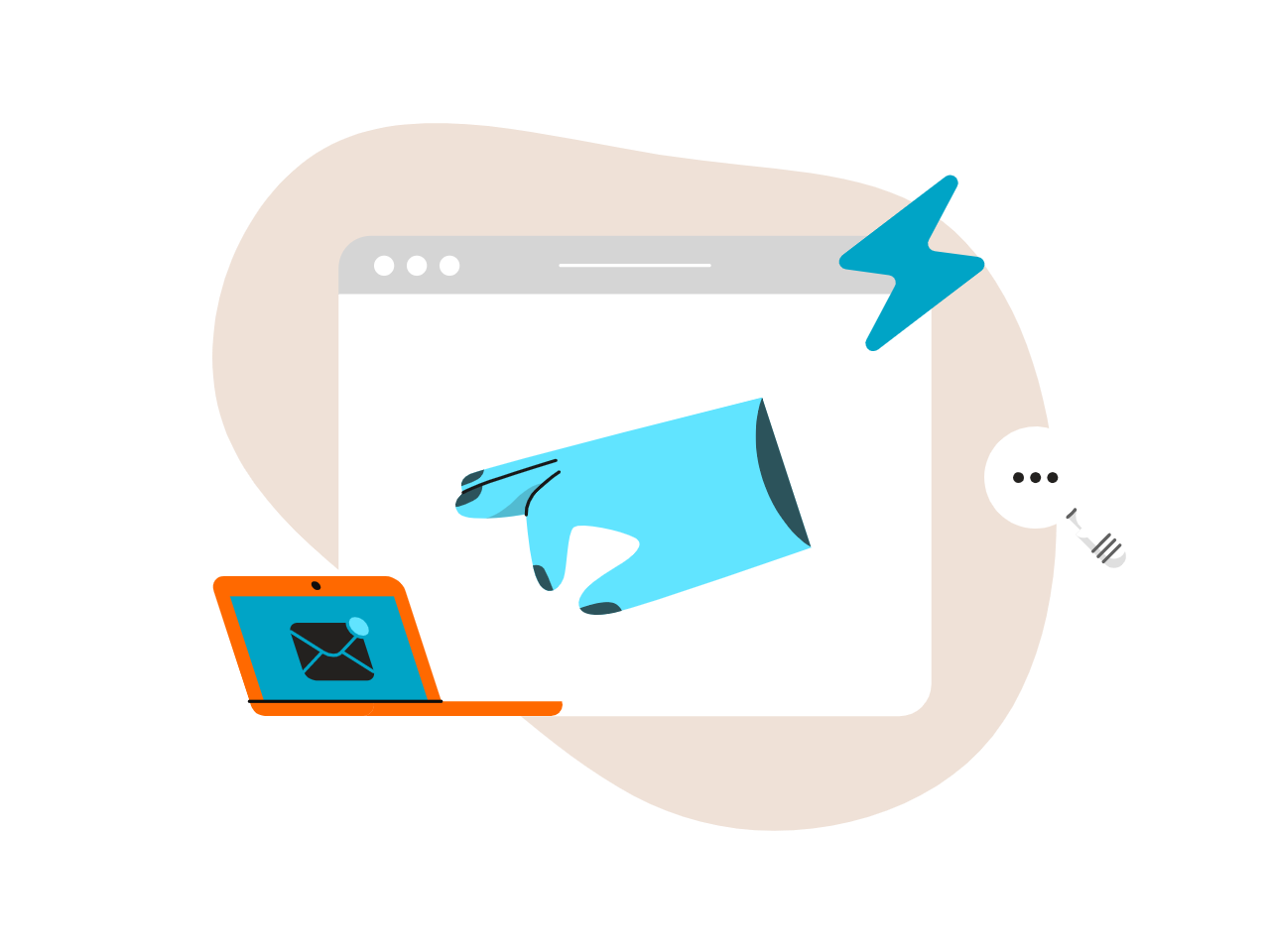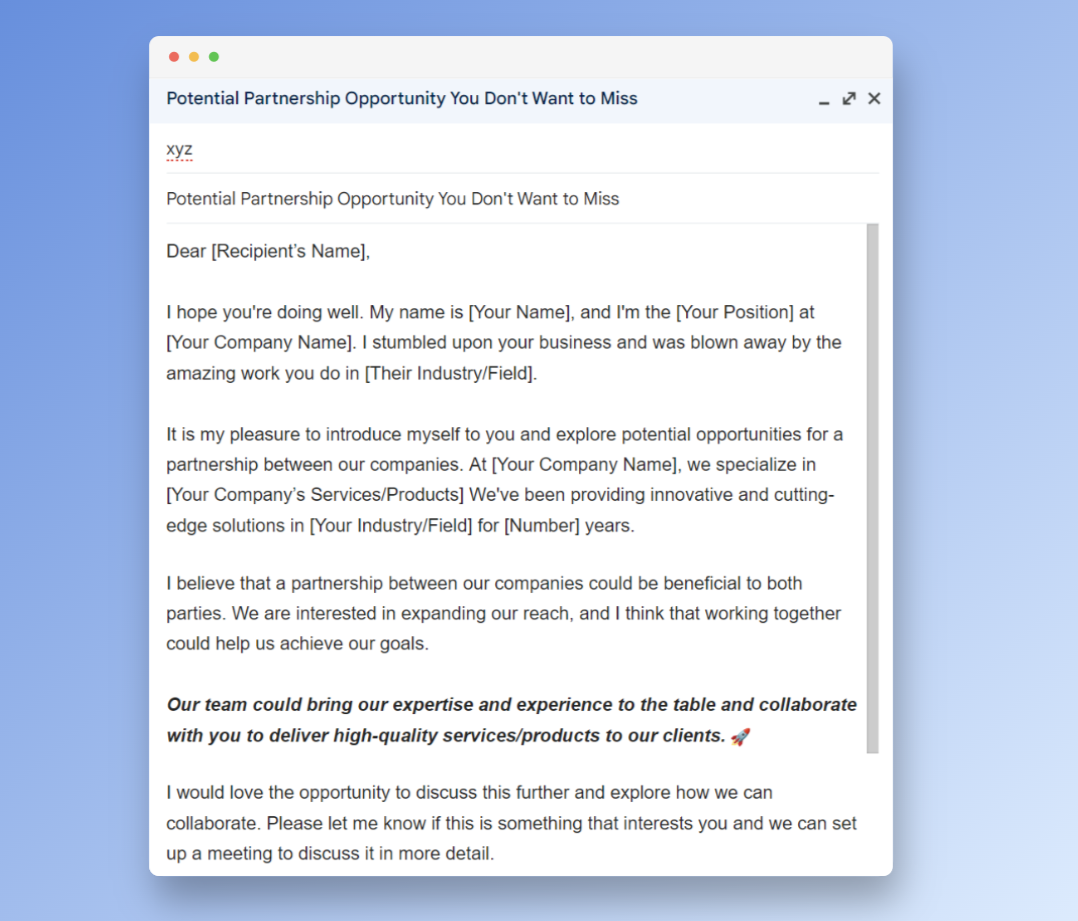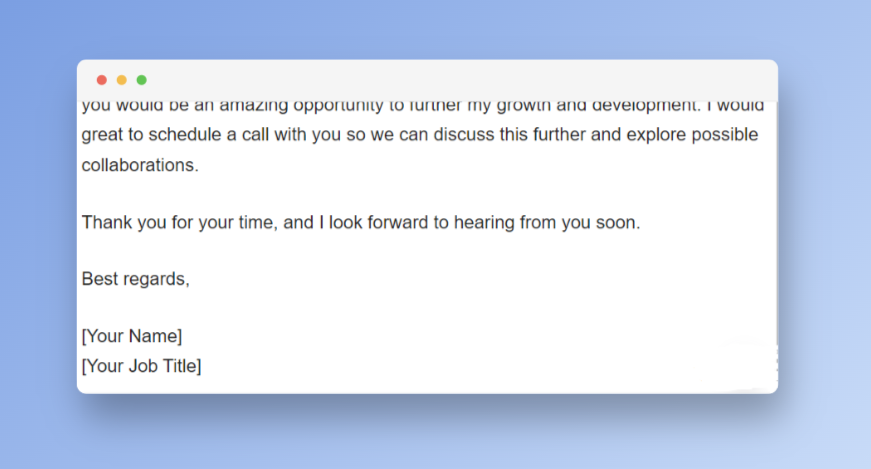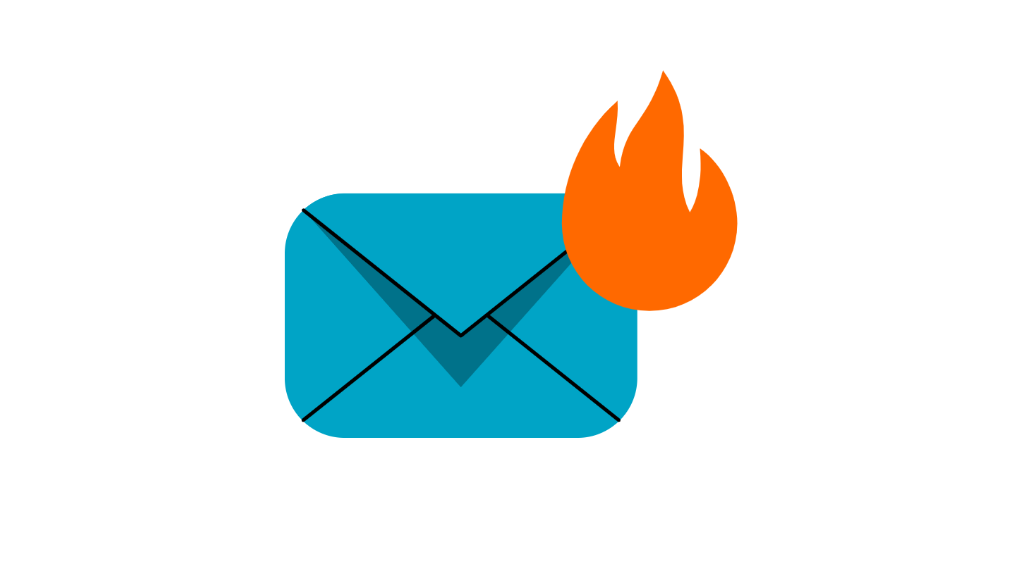You never get a second chance to make the first impression.
Let’s say you really want to make a good one. Then, would you wear a Hawaiian shirt and Crocs to the party if it had a formal dress code? Probably not. You would wear something more professional and business casual like a suede jacket? Probably not. It is exactly the same case as when you write an introductory email without knowing how to do it.
No worries! Today, you’ll learn how to write an effective introductory email step by step. Good news: templates are included. ✅
What is an introduction email?
An introduction email is a message that you send to a person you don’t know, and you want to introduce yourself or your company. It basically works as an icebreaker when meeting someone in a digital world.
Depending on whom you’re sending it to, this can be a cold email – if the recipient has not received messages from you before.
Think of this type of email as a friendly invitation to a conversation. On top of that, the intro email is your chance to build a professional relationship with the person (or a group of people) you reach out to.
However, the thing is that when mailing an unknown email address, you’re never quite sure if it’s not bounced back. It happens when you send a message to an address that doesn’t exist. It then returns and causes you problems.
And you don’t want to send your perfectly crafted masterpiece (introductory email) to the space, right? 🚀
To make sure your efforts are well-spent and your email reaches the right person, use Bouncer. We’ll make sure you’re sending your introduction emails to the right addresses, so you don’t need a follow-up email to get noticed.
So, roll your sleeves up, and let’s get started with writing your best introduction email ever.
Before you start writing your introduction email
But before typing the first words, take a moment to ponder a few critical things. Without thinking them over, writing would be tough, and you would feel lost.
Here are some points to keep in mind. 👇
🎯 Come with the purpose of the introduction email
No matter what email or piece of writing you are about to put together, knowing the purpose is the first (and critical) step. It might seem obvious and but it’s worth bringing it up once more.
Come up with a clear and concise purpose for your email. What’s your goal besides introducing yourself and your business? Maybe your priority is to:
- show your values to the recipient,
- introduce a new employee,
- connect for a product demo,
- discuss a marketing collaboration,
or whatever your purpose is, make sure it shines through your email.
🧍🏻 Identify the recipient
Who are the person or group you’re emailing to? Identifying the recipient is necessary if you want your message to get read and not just ignored or, worst-case scenario, deleted.
Above all, research the person you’re about to talk to.
Consider your interlocutor’s position in the company. Are they serious people whose goal is to do business? Perhaps you’re writing to someone you’d love to have as a mentor, and they’re not formal at all.
Knowing who will receive your email determines many other aspects of the email, like the tone of voice and language. You would talk differently to a chief marketing officer compared to a marketing intern, right?
What’s more, knowing who you are writing to enables you to create a personalized and language-wise appropriate communication style. Adjust the information you’re asking for (and sending) according to who your recipient is.
👔 Decide on the tone and style of your introduction email
The choice of voice and style might make or break the introductory email. And understanding your recipients’ preferences, personalities, and priorities makes it easier to decide what communication style to use.
Besides, when applying the tone, you can tailor your message to resonate with them on a deeper level.
Let’s have a look at the different tones of voice that you can use.
Thank you for your time and consideration. ➡️ Your time and thought are much appreciated.
I would be honored if you considered mentoring me. ➡️ Let me know if you agree to our collab. I would be super happy about it!
Remember that adjusting the message to the other person’s values may help you to convince them. However, still, be you. In general, the first message exchange is not the right place to joke or use sarcasm, but don’t create a fake version of yourself.
Once you meet your recipient in person or collaborate, any false impressions will be revealed.
🤔 Think of what others might think about your message
Put yourself in someone’s shoes. Imagine you’re your recipient – what emails are potentially catchy for you? What message would you want to open with curiosity if you were a businessman (or whoever that is)? What would make you keep reading?
Consider whether your product or service will fill a market gap. If yes, include this information in your message to grab the reader’s attention.
Sometimes changing the perspective may bring up new, better ideas. So, why not try this out?
OK! Now it’s time for some practice.

How to write an introductory email in 6 steps
Ready? Off we go.
STEP 1. Create an amazing subject line for your introduction email
It is the line of text at the top of an email that explains what the email is about. Email subject lines are the first thing that a recipient sees. And based on the headline, they are able to decide whether to open the email or not.
Make it catchy! But not in a clickbait way.
Otherwise, there’s a chance that your potential recipient will just ignore the message. It should be something captivating, relevant, and not generic. Phrases like “Hello” or “Introducing myself” may work, but you can do better! Scroll down for the examples.
Try to come up with something that will stand out from thousands of other messages in their inbox and grab the recipient’s attention.
Look at those subject line ideas.
➡️ Professional tone: #1 “Introducing[Company Name] and Exploring Possible Collaborations”
#2 “One-of-a-kind Collaboration Opportunity for [Company Name] and [Recipient’s Company Name]”
➡️ Casual tone: “Let’s Grab a Coffee and Chat about [shared interest]”
➡️ Playful tone: “[Company Name] Has a Proposal you Won’t Want to Miss”
➡️ Creative tone: “Idea for [Company Name]: [Unique and intriguing proposition]”
➡️ Personalized tone: “Mutual Passion for [Shared hobby/interest] – Let’s Connect!”
Feel free to adjust them as you like. Now, let’s move on to the next part.
STEP 2. Adjust your greeting as needed
The greeting is like an email introduction where you simply say hi. But you can also show your respect to the other person and build a mutual connection as well.
There are many ways in which you can do that. The most vital thing is to adjust it according to who you address your message to.
For example, opt for a professional tone if it’s a formal introduction email. Btw, the formal introduction email template is provided below.
But you set the rules for how you want your first line.
Check out email introduction examples.
➡️ Professional tone with a formal greeting: “Dear [Recipient’s Name], I hope this email finds you well.”
➡️ Casual tone: “Hi [Recipient’s Name], How’s it going?”
➡️ Respectful tone: “Good Morning/Afternoon/Evening [Recipient’s Name],”
➡️ Friendly tone: “Hey [Recipient’s Name], How are you doing today?”
➡️ Collaborative tone: “Hi [Recipient’s Name], Let’s work together to achieve the impossible!”
If you feel like going a bit casual with your prospective client (that is rather formal), why not risk it?

STEP 3. Explain what your intentions are and why you’re reaching out
The subject line and greetings are ready. Now it’s time for a specific explanation of your intentions. Include them in the email intro to make sure both you and your email recipients are on the same page.
And as in the case of a greeting and subject line, choose the tone you find appropriate.
Also, it’s a good place for a little self-introduction – write your first name (it’s not the time for contact details yet) and why you would like to get in touch with a person or company.
Don’t write too much, just the essentials. If you’re reaching out to a professional contact for networking purposes, you might mention that you’re curious about what they do and how you know about a company or a person.
In a nutshell: write a brief but specific explanation.
Check out some examples of how to write about intentions and reasons.
➡️ When writing to a potential mentor:
“I’m contacting you because I’m hoping to find a mentor who can provide me with career guidance. I have a keen interest in [Specific Areas or Skills] and would appreciate your expertise and experience.”
➡️ When writing to a prospective client:
“I came across your website and was impressed by your work in [Industry]. At [Your Company], we specialize in [Specific Service/Product], and I believe it could greatly benefit your business. I would love to connect and explore potential opportunities for collaboration.”
➡️ When writing to a future business partner:
“I am writing to introduce myself and explore potential opportunities for a partnership between our companies.”
STEP 4. Provide value before making an ask
Competition is big. Dropping a line about the value of your potential collaboration may encourage the reader to read on. So when writing to someone, mention potential benefits you offer before seeking collaboration opportunities.
TIP: write about something that your competitors are not able to provide. Be the dark horse candidate.
Take a look at our ideas.
➡️ When writing to a potential client:
“Our team could bring our expertise and experience to the table and collaborate with you to deliver high-quality services/products to our clients.”
➡️ When writing to a potential investor:
”We have successfully delivered high-quality [Your Company’s Services/Products] to our clients and have been experiencing significant growth in the past year. Therefore, our cooperation may benefit you as well.”
➡️ When writing to a potential mentor:
“I would like to discuss how we could work together and how I can be of value to you as well.”
STEP 5. Thank them for their time and attention
A person whom you write to has a busy schedule, probably. Maybe it’s an executive who makes an effort to give you their attention. Say thank you for that! One or two sentences are perfectly fine.
It also sets a positive tone for the rest of your interaction, making it more likely that they’ll be receptive to your message.
Taking care of details like a thank-you note shows you are thoughtful and considerate. And it goes a long way in building professional relationships.

Get inspired with some suggestions.
➡️ “Thank you for your time and consideration.”
➡️ “Your time and consideration are greatly appreciated. I look forward to hearing from you.”
➡️ “Thanks for your attention!”
STEP 6. End with a polite request
End your email with a positive note. How to create a polite and professional closing that won’t leave the other person feeling overwhelmed? Check out our tips:
- make sure you provided value before making your request
- explain your request clearly – avoid vague language
- show appreciation for their time and consideration
- be open to a “no,” or “not right now”
And find out our picks.
➡️ “Would you be available for a quick call next week to discuss this further?”
➡️ “Please let me know if this is something that interests you, and perhaps we can set up a meeting to discuss it in more detail.”
➡️ “I would be honored if you would consider the possibility of being my mentor.”
And finally, sign off and include contact information if your email signature doesn’t already have it.
And now, hit send! ✉️

Introduction emails: templates
Want to make a good impression with your professional email but still have some doubts about it? Feel free to use an introduction email template. We’ve provided a few of them in different styles.
Template 1: Formal introduction email to a potential client
Subject Line: One-of-a-kind Collaboration Opportunity for [Company Name] and [Recipient’s Company Name]
Dear [Recipient’s Name],
I hope this email finds you well. My name is [Your Name], and I’m [Your Job Title] at [Your Company]. I came across your website and was impressed by your work in [industry].
At [Your Company], we specialize in [specific service/product] and I believe it could be of great value to your business. [Explain how your company would bring value]. I would love to connect and explore potential opportunities for collaboration.
Would you be available for a quick call next week to discuss this further? I look forward to hearing from you soon. Thank you for your time.
Best regards,
[Your Name]
Template 2: Introduction email to a potential business partner
Subject: Introduction and Potential Partnership Opportunity
Dear [Recipient’s Name],
I hope this email finds you well. My name is [Your Name], and I am the [Your Position] at [Your Company Name]. I came across your business and was impressed by the work you do in [Their Industry/Field].
I am writing to introduce myself and explore potential opportunities for a partnership between our companies. At [Your Company Name], we specialize in [Your Company’s Services/Products] and have been successful in delivering innovative solutions to clients in [Your Industry/Field] for [Number] years.
I believe that a partnership between our companies could be mutually beneficial. We are interested in expanding our reach and I think that working together could help us achieve our goals. Our team could bring our expertise and experience to the table and collaborate with you to deliver high-quality services/products to our clients.
I would love the opportunity to discuss this further and explore how we can collaborate. Please let me know if this is something that interests you and we can set up a meeting to discuss it in more detail.
Thank you for your time and consideration.
Sincerely,
[Your Name]
[Your Job Title]
[Your Company Name]
Template 3: Introduction email to a potential mentor
Subject: Seeking Mentorship and New Challenges
Hi [Mentor’s Name],
I hope this email finds you doing well. What about grabbing a coffee and chatting about [Shared Interest]?
My name is [Your Name] and I am a [Your Position/Field] who has been following your work for some time. I am incredibly impressed and inspired by your achievements and contributions to [Their Industry/Field or Your Field].
In my career development, I am seeking a mentor who can provide me with guidance. I am particularly interested in finding out more about [Specific Areas or Skills], and I believe that your experience and expertise could be valuable in helping me achieve my goals.
I have researched your background and have been blown away by your [Noteworthy Achievements or Contributions]. I would be honored if you would consider the possibility of being my mentor. Having the opportunity to work with you would provide me with valuable insights and guidance that would help me grow both personally and professionally.
I understand that you’ve got a lot on your plate, but I would be veeerygrateful for any time you could spare for me. I would like to discuss how we could work together and how I can be of value to you as well.
Your time and consideration are greatly appreciated. I look forward to hearing from you.
Regards,
[Your Name]
Common mistakes to avoid when crafting an introduction email
Check them out!
01 Not validating the email address
Sign up to Bouncer to validate your addressee’s email address.
The last thing you want is to miss the opportunity to work with the best specialists in your industry only because you haven’t checked on the address, right?
02 Failing to proofread the email
Before sending anything to anyone, it’s helpful to have a habit of rereading the text. When writing to a potential business partner, you don’t want to misspell their company name, do you?
03 Including a bland and uninformative subject line
An attention-grabbing header really does the job! Writing a bland introduction email subject line is a missed opportunity to make a memorable first impression.
04 Keeping the email too long or sending separate emails instead of one
No one likes reading super-long messages. Keep your self-introduction email straight to the point. Additionally, avoid sending separate emails. Instead, craft one that includes all necessary information.
05 Being too generic and beating around the bush
Business people like getting straight to the point. So, writing generic messages with no intentions included is your own goal because it is very probable that your message will go unread.
06 Ignoring relevant information (e.g., company’s name or job title, mutual contact info)
With our compelling step-by-step guide, you’ll make sure you cover everything. However, it’s a good practice to go through the email just before sending it to ensure everything is right in place.
Write a great introduction email today!
Make a professional introduction email so good that they can’t help but click that reply button. ✨
Writing an effective one may seem challenging. But by following the tips outlined in the article, you can create a memorable email and a positive first impression. Good luck!
Introduction email: frequently asked questions:
How long should an introduction email be?
A couple of sentences is ideal. You want to stand out and brevity helps with that.
When is the best time to send an introductory email?
It depends, but weekdays at working hours are the best. Aim for a day other than Friday.
What’s the worst introduction email mistake to make?
There are a few, but probably the worst one would be to make the email too long. It will automatically not get read when the recipient sees a wall of text. Second would be an uninteresting and overly long subject line.
Is validating emails really that important?
Yes, because if you’re sending emails to unverified addresses, you don’t know if these are real people or not and you might get a lot of hard bounces and hurt your sender reputation.





